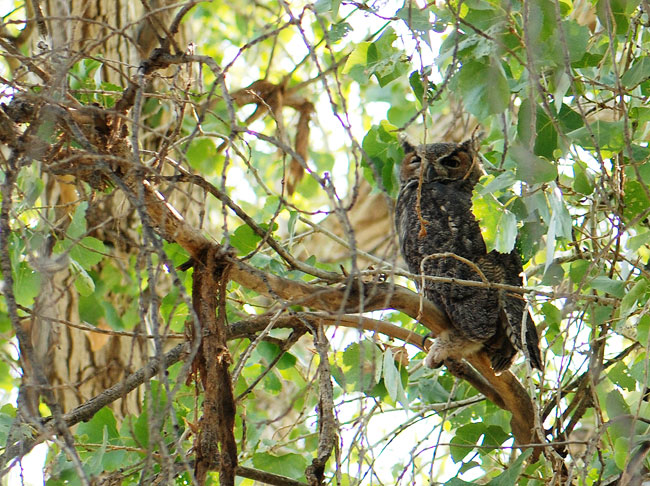During a recent quiet morning walk I spotted something unexpected,
 a great horned owl napping in a cottonwood tree!
a great horned owl napping in a cottonwood tree!
I had some questions, so when I got back home I pulled out the new children’s informational book Great Horned Owls by Melissa Hill and Gail Saunders-Smith, PhD (Consultant Editor) to find out more (It is Nonfiction Monday, after all.)
Are great horned owls common in the desert? Checking the map of where great horned owls live, it turns out they are found throughout North America and parts of South America. There is even a photograph showing a great horned owl nesting in a saguaro cactus. Another source suggests that great horned owls catch and eat scorpions, which makes sense since they are both active at night. Great horned owls do live in the desert.
Looking at the large photographs in the book, it was also surprising to see that the feathers of the great horned owl vary in color. Some great horned owls are predominately dark like the one in my photograph, some have more reddish-brown feathers, and others are quite pale in color. All have the tall tufts of feathers on their heads, however, that give them the name “horned.”
Did you know that owls don’t build their own nests? It turns out they use cavities in trees, nests built by other large birds, or even nests built by squirrels as places to lay their eggs. After laying, the female incubates the eggs for about a month, while the male brings her food. Once the baby owls hatch, both parents feed them.
Great Horned Owls helps early readers learn new vocabulary while exploring age-appropriate facts about these fascinating nocturnal creatures. Reading it will allow them to become as wise as owls!
Age Range: 4 – 8 years
Grade Level: Kindergarten – 1
Publisher: Capstone Press (August 1, 2015)
ISBN-10: 1491460539
ISBN-13: 978-1491460535
Related Activities:
Hear owls hooting, see highlight videos from a great horned owl nest cam, as well as visit an extensive list of great horned owl FAQs from the Cornell Lab of Ornithology.
Related books from Capstone:
Burrowing Owls by Melissa Hill and Gail Saunders-Smith, PhD (Consultant Editor) is another title from the new Owls series.
Burrowing owls are small owls that live in tunnels in the ground. They are also commonly found in the desert.
Age Range: 4 – 8 years
Publisher: Capstone Press (August 1, 2015)
ISBN-10: 1491460466
ISBN-13: 978-1491460467
Why Do Owls and Other Birds Have Feathers? (Animal Body Coverings) by Holly Beaumont is new title that explains how owls use their feathers to keep warm and to fly, among other things.
Age Range: 5 – 7 years
Publisher: Heinemann (August 1, 2015)
ISBN-10: 1484625382
ISBN-13: 978-1484625385
Don’t forget our growing list of books about birds for children at Science Books for Kids.
Disclosure: These books were provided by the publisher for review purposes. Also, I am an affiliate with Amazon so I can provide you with cover images and links to more information about books and products. As you probably are aware, if you click through the highlighted title or cover links and purchase a product, I will receive a very small commission, at no extra cost to you. Any proceeds help defray the costs of hosting and maintaining this website.
Looking for more children’s nonfiction books? Try the Nonfiction Monday blog.


















